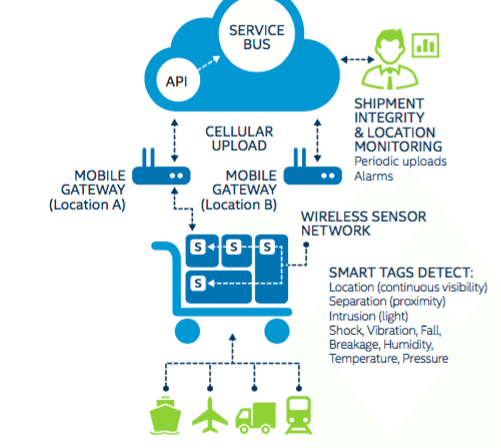The chipmaker will use the technology for its own supply chain
Intel and Honeywell have partnered to create a new solution for shippers that leverages cellular technology and a proprietary Wi-Fi protocol developed by Intel. Three logistics providers – DHL, Expeditors and Kuehne + Nagel – helped Intel and Honeywell develop the connected supply chain solution.
Chet Hullum, general manager for industrial solutions at Intel, said the two companies created the solution based on in-depth conversations with shippers and logistics companies, as well as food service providers and other companies that sell perishable merchandise. He said these customers will gain real-time visibility into freight shipments by utilizing sensors equipped with Intel chipsets to connect to a smart gateway, which uses 3G networks to connect to Honeywell’s platform. Hullum said the customers that the companies talked with were asking for 3G, not LTE, because they wanted a technology that is more widely available in many parts of the world. He said the gateways could potentially be updated to LTE at a later date via a USB-connected hardware add-on.
The gateways, which are manufactured by Honeywell, are based on Intel’s SoFIA 3GR platform and are about the size of a large smartphone, Hullum said. The gateways can be customized and configured remotely. They are certified for AT&T’s network, and Hullum said they will also be “MVNO-enabled” for customers who want to work with a different carrier.
The solution will be marketed to shippers and logistics providers by Honeywell. Hullum said that Intel sees partnerships like this as an effective way to approach the market for IoT solutions.
Intel itself will use the solution to track and manage its own shipments. The company said it ships more than 170,000 tons of goods and materials every year.
“Imagine the possibilities when these shipments are smart and connected,” said Tony Romero, VP and general manager for customer fulfillment, planning and logistics at Intel. “The data gathered and communicated en route will help us improve numerous business decisions like rerouting if demand shifts or intercepting a damaged shipment.”
Hullum said the sensors use a proprietary Wi-Fi mesh protocol developed by Intel to communicate with one another and with the gateways. He said that because the sensors can connect to one another, Intel did not need to use a wide area network protocol like LoRa.
The sensors can be attached to assets or to pallets, and users can establish alerts based on temperature, shock, tilt, humidity, pressure and intrusion detection.
Although the sensors are labeled as Honeywell hardware, Intel sources these chips from a third party provider of microcontrollers. Hullum said Intel can port its architecture to other providers at a future date if other microcontrollers need to become part of the solution.

